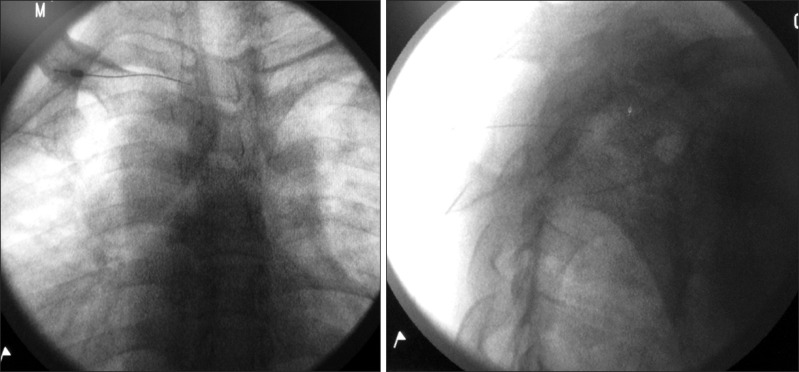Korean J Pain.
2013 Oct;26(4):401-405. 10.3344/kjp.2013.26.4.401.
Percutaneous T2 and T3 Radiofrequency Sympathectomy for Complex Regional Pain Syndrome Secondary to Brachial Plexus Injury: A Case Series
- Affiliations
-
- 1Department of Anesthesiology, Kuching Specialist Hospital, Sarawak, Malaysia. chenck@hotmail.my
- 2Department of Medicine, Sarawak General Hospital, Sarawak, Malaysia.
- 3Department of Anesthesiology, University Science Malaysia Hospital, Kelantan, Malaysia.
- 4The Pain Specialist' Clinic, Mt. Elizabeth Medical Centre, Singapore.
- KMID: 2074051
- DOI: http://doi.org/10.3344/kjp.2013.26.4.401
Abstract
- Complex regional pain syndrome secondary to brachial plexus injury is often severe, debilitating and difficult to manage. Percuteneous radiofrequency sympathectomy is a relatively new technique, which has shown promising results in various chronic pain disorders. We present four consecutive patients with complex regional pain syndrome secondary to brachial plexus injury for more than 6 months duration, who had undergone percutaneous T2 and T3 radiofrequency sympathectomy after a diagnostic block. All four patients experienced minimal pain relief with conservative treatment and stellate ganglion blockade. An acceptable 6 month pain relief was achieved in all 4 patients where pain score remained less than 50% than that of initial score and all oral analgesics were able to be tapered down. There were no complications attributed to this procedure were reported. From this case series, percutaneous T2 and T3 radiofrequency sympathectomy might play a significant role in multi-modal approach of CRPS management.
MeSH Terms
Figure
Cited by 1 articles
-
Multicenter survey of symptoms, work life, economic status, and quality of life of complex regional pain syndrome patients
Jaemoon Lee, Yun Hee Lim, Sung Jun Hong, Jae Hun Jeong, Hey Ran Choi, Sun Kyung Park, Jung Eun Kim, Eun Hi Park, Jae Hun Kim
Korean J Pain. 2021;34(3):288-303. doi: 10.3344/kjp.2021.34.3.288.
Reference
-
1. Htut M, Misra P, Anand P, Birch R, Carlstedt T. Pain phenomena and sensory recovery following brachial plexus avulsion injury and surgical repairs. J Hand Surg Br. 2006; 31:596–605. PMID: 16822598.
Article2. Boas RA. Sympathetic nerve blocks: in search of a role. Reg Anesth Pain Med. 1998; 23:292–305. PMID: 9613543.3. Yucel I, Demiraran Y, Ozturan K, Degirmenci E. Complex regional pain syndrome type I: efficacy of stellate ganglion blockade. J Orthop Traumatol. 2009; 10:179–183. PMID: 19888550.
Article4. Ramsaroop L, Partab P, Singh B, Satyapal KS. Thoracic origin of a sympathetic supply to the upper limb: the 'nerve of Kuntz' revisited. J Anat. 2001; 199:675–682. PMID: 11787821.
Article5. Wilkinson HA. Percutaneous radiofrequency upper thoracic sympathectomy. Neurosurgery. 1996; 38:715–725. PMID: 8692390.
Article6. Merskey H, Bogduk N. Classification of chronic pain: descriptions of chronic pain syndromes and definitions of pain terms. 2nd ed. Seattle (WA): IASP Press;1994. p. 40–43.7. Stanton-Hicks MD, Burton AW, Bruehl SP, Carr DB, Harden RN, Hassenbusch SJ, et al. An updated interdisciplinary clinical pathway for CRPS: report of an expert panel. Pain Pract. 2002; 2:1–16. PMID: 17134466.
Article8. Kim WY, Moon DE, Choi JH, Park CM, Han SM, Kim SH. The effect of spinal cord stimulation in patients with complex regional pain syndrome. Korean J Pain. 2006; 19:152–158.
Article9. McCormack AC, Jarral OA, Shipolini AR, McCormack DJ. Does the nerve of Kuntz exist? Interact Cardiovasc Thorac Surg. 2011; 13:175–178. PMID: 21602419.
Article10. Raj PP, Erdine S. Pain-relieving procedures: the illustrated guide. 1st ed. West Sussex: Wiley-Blackwell;2012. p. 244–249.11. Yang JY, Kim C, Han KR, Cho HW, Kim EJ. Dorsal percutaneous thoracic sympathetic ganglion block with alcohol for the treatment of palmar hyperhidrosis. Korean J Pain. 2005; 18:171–175.
Article12. Agarwal-Kozlowski K, Lorke DE, Habermann CR, Schulte am, Beck H. Interventional management of intractable sympathetically mediated pain by computed tomography-guided catheter implantation for block and neuroablation of the thoracic sympathetic chain: technical approach and review of 322 procedures. Anaesthesia. 2011; 66:699–708. PMID: 21564048.
Article13. Herz DA, Looman JE, Ford RD, Gostine ML, Davis FN, VandenBerg WC. Second thoracic sympathetic ganglionectomy in sympathetically maintained pain. J Pain Symptom Manage. 1993; 8:483–491. PMID: 7525779.
Article
- Full Text Links
- Actions
-
Cited
- CITED
-
- Close
- Share
- Similar articles
-
- Brachial Plexus Injury after Thoracoscopic Sympathectomy: A case report
- Brachial Plexopathy Associated with Thoracoscopic Sympathectomy for Treatment of Primary Hyperhidrosis: A Case Report
- Percutaneous bipolar radiofrequency T3 sympathicotomy in Raynaud's disease: A case report
- Effects of Interscalene Brachial Plexus Block Combined with Patient Controlled Analgesia in a Patient with CRPS: A case report
- Clinical Experience of a Complex Regional Pain Syndrome Type II Patient: A case report


